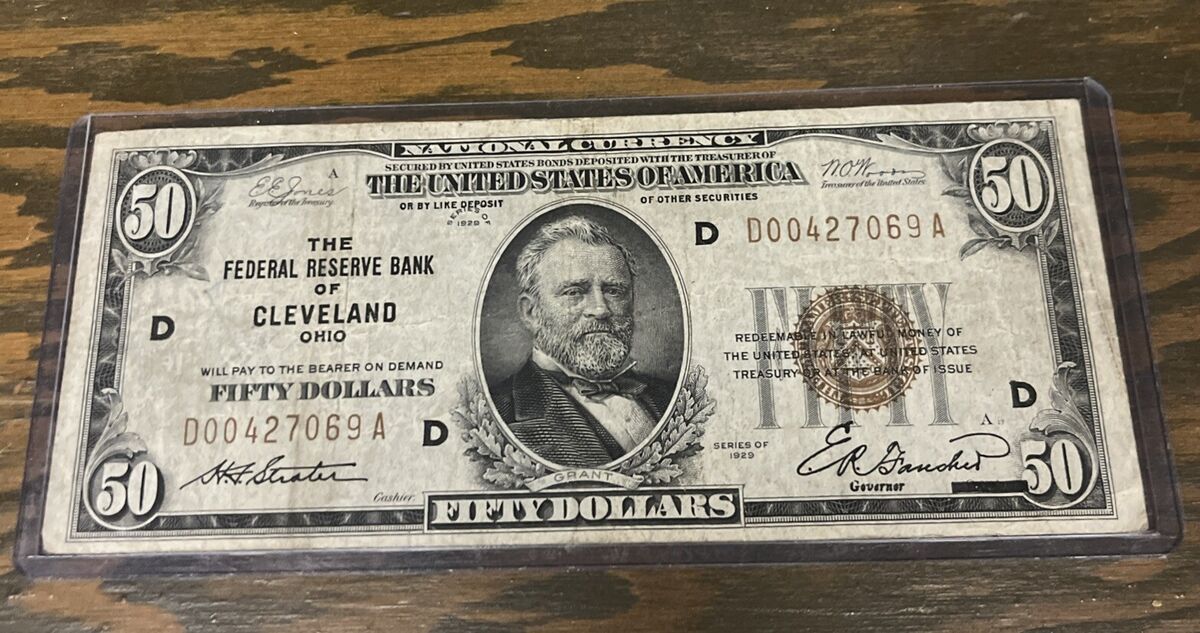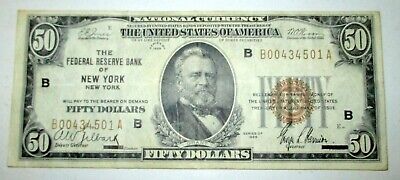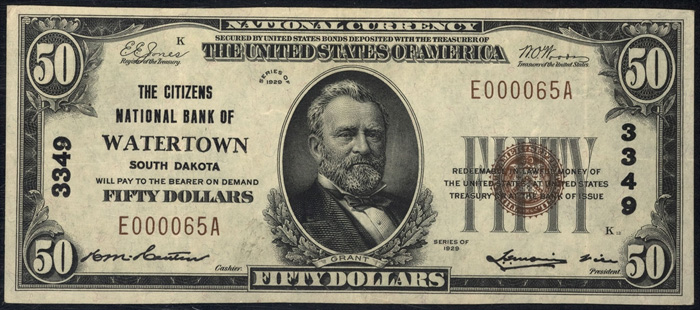The 1929 50 dollar bill holds a significant place in the history of American currency. As part of the broader series of currency notes released in 1929, these bills offer not only a glimpse into the era’s economic landscape but also a valuable collector’s item for currency enthusiasts. Whether you possess one of these bills or are considering purchasing one, it is important to understand the details surrounding their different types, historical context, and the factors that influence their worth.
In this article, we will explore the 1929 $50 bill, the different variations of $50 bills from that era, and the factors that determine their value today.

Overview Of The 1929 $50 Dollar Bill
The 1929 $50 dollar bill, a piece of paper money from the series issued that year, falls under two primary categories: Federal Reserve Bank Notes and National Bank Notes. While both types of bills were issued in the same year, there is a subtle difference between them, which plays a role in their overall value and scarcity in today’s market.
This is important for collectors or anyone interested in the worth of a 50 dollar bill, as it impacts the valuation.
In both cases, the 1929 $50 dollar bill features a portrait of Ulysses S. Grant, the 18th President of the United States, and is marked with the phrase “Fifty Dollars.”
However, the distinction between Federal Reserve Bank Notes and National Bank Notes is found in the inscription on the front of the bill.
Federal Reserve Bank Notes will bear the seal and designation of one of the twelve Federal Reserve Banks, while National Bank Notes will have the name of a National Bank. This difference, while subtle, is crucial for determining the bill’s origin and, consequently, its value.
Federal Reserve Bank Notes
Federal Reserve Bank Notes issued in 1929 for the $50 bill generally have a lower value compared to National Bank Notes. However, their worth can still be quite impressive depending on the bill’s condition. Most 1929 Federal Reserve Bank Notes in very good condition are worth around $95.
The value rises for bills in better condition, with those in very fine condition reaching a value of approximately $145. A bill in uncirculated condition, graded at MS 63, can fetch around $375. It’s important to note that bills from certain Federal Reserve Banks, such as the Federal Reserve Bank of Dallas, tend to be more valuable.
Additionally, star notes—bills that were printed as replacements for misprinted currency—will generally sell for higher prices than regular bills of the same type.
National Bank Notes: Type 1 and Type 2
National Bank Notes issued as part of the 1929 $50 bill series come in two types: Type 1 and Type 2. Both of these types appear very similar at first glance, but they have subtle differences that are important for collectors.
Type 1 notes do not feature any bank charter numbers on the bill’s front.
In contrast, Type 2 notes include the bank charter numbers located on the lower left and upper right corners of Grant’s portrait.
For Type 1 notes, values can vary based on condition. A Type 1 bill in very good condition might be worth around $150, while in very fine condition, it could fetch around $250.
A well-preserved, uncirculated Type 1 bill can be worth approximately $600 if graded at MS 63.
Type 2 notes, which include the bank charter numbers, are slightly more valuable than their Type 1 counterparts. In very good condition, a Type 2 bill is typically worth about $200.
As the condition improves, the value increases—very fine bills can reach $315, while uncirculated bills with an MS 63 grade can fetch up to $725.
Factors Affecting the Value Of The 1929 $50 Dollar Bill
Several factors play a crucial role in determining the current value of a $50 bill from 1929. Condition, type, and rarity are the primary considerations.
- Condition: The condition of the bill is one of the most significant factors influencing its value. The grading system for currency notes, such as “very good,” “very fine,” and “MS 63” (choice uncirculated), helps collectors assess a bill’s state. A 50 dollar bill in better condition will naturally be worth more than one that shows significant wear or damage. Bills that are crisp, clean, and free of tears, stains, or folds are highly sought after by collectors.
- Type: As mentioned earlier, the type of bill—whether it’s a Federal Reserve Bank Note or a National Bank Note—can impact its value. Furthermore, within National Bank Notes, the Type 1 and Type 2 distinctions affect the bill’s worth. Star notes, which were printed to replace damaged or defective notes, are usually valued higher due to their rarity.
- Rarity: Some fifty dollar bills are rarer than others, which naturally increases their value. Factors such as how many bills were issued by specific Federal Reserve Banks, or whether a particular bank’s notes were less common in circulation, can influence the rarity and demand for the bill.
- Errors: Like other types of currency, errors on the 50 dollar bill can greatly increase its value. These errors may range from printing mistakes, such as misaligned ink or incorrect serial numbers, to more rare occurrences like missing security features. Collectors place a premium on these error notes, making them worth significantly more than standard, error-free notes of the same type and condition.
What Is The Worth Of $50 in 1929?
To understand the value of the 1929 $50 bill today, it’s important to consider its purchasing power in the context of historical inflation. According to the U.S. Bureau of Labor Statistics’ inflation calculator, $50 in 1929 would be equivalent to approximately $922.82 in today’s money.

This means that the fifty dollar bill from 1929 held significant purchasing power, even by today’s standards, and its value has only increased with time.
The cumulative inflation rate from 1929 to today is a staggering 1,745.64%. This dramatic increase in the cost of goods and services highlights the changing economic conditions over nearly a century and underscores the growing importance of the 50 dollar bill as a historical artifact.
Grading and Preservation Of The 1929 $50 Dollar Bill
For collectors and enthusiasts, properly grading and preserving the paper money is vital to maintaining its value. Currency should be stored carefully to avoid damage such as folding, creasing, or exposure to moisture, which can reduce its worth.
Special holders and protective cases designed for currency can help ensure that the bill remains in pristine condition, preserving its appearance and value for generations to come.
Grading involves examining the bill for any signs of wear, discoloration, or damage. Very good notes typically show signs of handling, with some visible tears or creases, while very fine notes have minor signs of wear and remain relatively crisp. Uncirculated notes are those that show no signs of ever being in circulation and retain their original crispness.
Conclusion
The 1929 $50 dollar bill is more than just a piece of currency—it is a historical relic that has become a sought-after collectible in today’s market.
The worth of your 50 dollar bill depends largely on its condition, type, rarity, and any potential errors it might contain.
As the 50 dollar bill continues to gain in value, it serves as a testament to the changing landscape of American money and the enduring fascination with currency history.
Considering selling a 1929 50 dollar bill or simply wish to learn more about its historical and financial significance, it’s clear that this bill, regardless of its condition or variations, holds substantial value in the eyes of collectors and investors alike.

